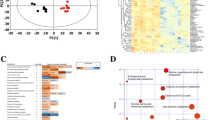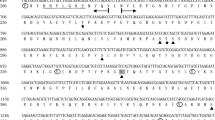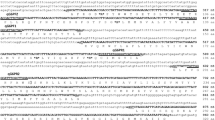Abstract
Glycogen, a polymer of glucose, is an important means of storing energy. It is degraded by glycogen phosphorylase (GPH) and hexokinase (HK), glycogen phosphorylase, and hexokinase cDNAs (Ca-GPH and Ca-HK, respectively), which encode the primary enzymes involved in glycogen use, cloned and characterized and used to investigate the regulation of glycogen metabolism at the mRNA level in Crassostrea angulata. Their expression profiles were examined in different tissues and during different reproductive stages. Full-length cDNA of GPH was 3 078 bp in length with a 2 607 bp open reading frame (ORF) predicted to encode a protein of 868 amino acids (aa). The full-length HK cDNA was 3 088 bp long, with an ORF of 1 433 bp, predicted to encode a protein of 505 aa. Expression levels of both genes were found to be significantly higher in the gonads and adductor muscle than in the mantle, gill, and visceral mass. They were especially high in the adductor muscle, which suggested that these oysters can use glycogen to produce a readily available supply of glucose to support adductor muscle activity. The regulation of both genes was also found to be correlated with glycogen content via qRT-PCR and in situ hybridization and was dependent upon the stage of the reproductive cycle (initiation, maturation, ripeness). In this way, it appears that the expression of Ca-GPH and Ca-HK is driven by the reproductive cycle of the oyster, reflecting the central role played by glycogen in energy use and gametogenic development in C. angulata. It is here suggested that Ca-GPH and Ca-HK can be used as useful molecular markers for identifying the stages of glycogen metabolism and reproduction in C. angulata.
Similar content being viewed by others
References
Allen D G, Lamb G D, Westerblad H. 2008. Skeletal muscle fatigue: cellular mechanisms. Physiological Reviews, 88(1): 287–332
Appleyard S A, Ward R D. 2006. Genetic diversity and effective population size in mass selection lines of Pacific oyster (Crassostrea gigas). Aquaculture, 254(1–4): 148–159
Bacca H, Huvet A, Fabioux T, et al. 2005. Molecular cloning and seasonal expression of oyster glycogen phosphorylase and glycogen synthase genes. Comparative Biochemistry and Physiology Part B: Biochemistry and Molecular Biology, 140(4): 635–646
Barber B J, Blake N J, 1981. Energy storage and utilization in relation to gametogenesis in Argopecten irradians concentricus (say). Journal of Experimental Marine Biological and Ecology, 52(2–3): 121–134
Bayne B L. 1976. Aspects of reproduction in bivalve molluscs. In: Wiley M L, ed. Estuarine Process. New York: Academic Press, 432–448
Bayne B L, Bubel A, Gabbott P A, et al. 1982. Glycogen utilisation and gametogenesis in Mytilus edulis L.. Marine Biology Letters, 3(2): 89–105
Bergström J, Hermansen L, Hultman E, et al. 1967. Diet, muscle glycogen and physical performance. Acta Physiologica Scandinavica, 71(2): 140–150
Berthelin C, Kellner K, Mathieu M. 2000a. Storage metabolism in the Pacific oyster (Crassostrea gigas) in relation to summer mortalities and reproductive cycle (West Coast of France). Comparative Biochemistry and Physiological Part B: Biochemistry and Molecular Biology, 125(3): 359–369
Berthelin C, Kellner K, Mathieu M. 2000b. Histological characterization and glucose incorporation into glycogen of the Pacific oyster Crassostrea gigas storage cells. Marine Biotechnology, 2(2): 136–145
Bork P, Sander C, Valencia A. 1993. Convergent evolution of similar enzymatic function on different protein folds: the hexokinase, ribokinase, and galactokinase families of sugar kinases. Protein Science, 2(1): 31–40
Butt D, Raftos D. 2008. Phenoloxidase-associated cellular defense in the Sydney rock oyster, Saccostrea glomerata, provides resistance against QX disease infections. Developmental & Comparative Immunology, 32(3): 299–306
Cárdenas M L, Cornish-Bowden A, Ureta T. 1998. Evolution and regulatory role of the hexokinases. Biochimica et Biophysica Acta-Molecular Cell Research, 1401(3): 242–264
Cavener D R. 1980. Genetics of male-specific glucose oxidase and the identification of other unusual hexose enzymes in Drosophila melanogaster. Biochemical Genetics, 18(9–10): 929–937
Chandrashekar P M, Bali G. 1987. Glycogen level and glycogen phosphorylase activity in the eggs of silkworm Bombyx mori L.. Proceedings: Animal Sciences, 96(1): 49–54
Chen Chengping, Denlinger D L. 1990. Activation of phosphorylase in response to cold and heat stress in the flesh fly, Sarcophaga crassipalpis. Journal of Insect Physiology, 36(8): 549–553
Childress C C, Sacktor B. 1970. Regulation of glycogen metabolism in insect flight muscle. Purification and properties of phosphorylases in vitro and in vivo. The Journal of Biological Chemistry, 245(11): 2927–2936
Colowick S P. 1973. The hexokinases. In: Boyer P D, ed. The Enzymes. New York: Academic Press
Crerar M M, Hudson J W, Mattews K E, et al. 1988. Studies on the expression and evolution of the glycogen phosphorylase gene family in the rat. Genome, 30(4): 582–590
Dégremont L, Ernande B, Bédier E, et al. 2007. Summer mortality of hatchery-produced Pacific oyster spat (Crassostrea gigas): I. Estimation of genetic parameters for survival and growth. Aquaculture, 262(1): 41–53
Dohmen M R. 1983. Gametogenesis. In: Verdonk N H, Van den Biggelaar J A M, Tompa A S, et al., eds. The Mollusca. New York: Academic Press, 1–48
Duvernell D D, Eanes W F. 2000. Contrasting molecular population genetics of four hexokinases in Drosophila melanogaster, D. simulans and D. yakuba. Genetics, 156(3): 1191–1201
Eivers E, Demagny H, De Robertis E M. 2009. Integration of BMP and Wnt signaling via vertebrate Smad1/5/8 and Drosophila Mad. Cytokine & Growth Factor Reviews, 20(5–6): 357–365
Epp J, Bricelj V M, Malouf R E. 1988. Seasonal partitioning and utilization of energy reserves in two age classes of the bay scallop Argopecten irradians irradians (Lamarck). Journal of Experimental Marine Biological and Ecology, 121(2): 113–136
Evans S, Langdon C. 2006. Direct and indirect responses to selection on individual body weight in the Pacific oyster (Crassostrea gigas). Aquaculture, 261(2): 546–555
Fabioux C, Huvet A, Le Souchu P, et al. 2005. Temperature and photoperiod drive Crassostrea gigas reproductive internal clock. Aquaculture, 250(1–2): 458–470
Fabioux C, Pouvreau S, Roux F L, et al. 2004. The oyster vasa-like gene: a specific marker of the germline in Crassostrea gigas. Biochemical and Biophysical Research Communications, 315(4): 897–904
Fletterick R J, Madsen N B. 1980. The structures and related functions of phosphorylase a. Annual Review of Biochemistry, 49: 31–61
Ford W C, Candy D J. 1972. The regulation of glycolysis in perfused locust flight muscle. Biochemical Journal, 130(4): 1101–1112
Fraga A, Ribeiro L, Lobato M, et al. 2013. Glycogen and glucose metabolism are essential for early embryonic development of the red flour beetle Tribolium castaneum. PLoS One, 8(6): e65125
Frame S, Cohen P. 2001. GSK3 takes centre stage more than 20 years after its discovery. Biochemical Journal, 359(1): 1–16
Fritz H L, Smoak I W, Branch S. 1999. Hexokinase I expression and activity in embryonic mouse heart during early and late organogenesis. Histochemistry and Cell Biology, 112(5): 359–365
Frommer W B, Schulze W X, Lalonde S. 2003. Plant science. Hexokinase, Jack-of-all-trades. Science, 300(5617): 261–263
Fueger P T. 2005. Glucose phosphorylation as a barrier to muscle glucose uptake. Clinical and Experimental Pharmacology & Physiology, 32(4): 314–318
Fuentealba L C, Eivers E, Ikeda A, et al. 2007. Integrating patterning signals: Wnt/GSK3 regulates the duration of the BMP/Smad1 signal. Cell, 131(5): 980–993
Greenberg C C, Jurczak M J, Danos A M, et al. 2006. Glycogen branches out: new perspectives on the role of glycogen metabolism in the integration of metabolic pathways. American Journal of Physiology Endocrinology and Metabolism, 291(1): E1–E8
Greiwe J S, Hickner R C, Hansen P A, et al. 1999. Effects of endurance exercise training on muscle glycogen accumulation in humans. Journal of Applied Physiology, 87(1): 222–226
Guo X M. 2004. Oyster breeding and the use of biotechnology. Bulletin of the Aquaculture Association of Canada, 104(2): 26–33
Horikoshi H. 1958. Glycogen. Chem Field (in Japanese), 34: 36–39
Huvet A, Fabioux C, Mccombie H, et al. 2004. Natural hybridization between genetically differentiated populations of Crassostrea gigas and C. angulata highlighted by sequence variation in flanking regions of a microsatellite locus. Marine Ecology Progress Series, 272: 141–152
Huvet A, Gérard A, Ledu C, et al. 2002. Is fertility of hybrids enough to conclude that the two oysters Crassostrea gigas and Crassostrea angulata are the same species?. Aquatic Living Resources, 15(1): 45–52
Irimia J M, Rovira J, Nielsen J N, et al. 2012. Hexokinase 2, glycogen synthase and phosphorylase play a key role in muscle glycogen supercompensation. PLoS One, 7(7): e42453
Jayakumar P C, Shouche Y S, Patole M S. 2001. Cloning of two hexokinase isoenzyme sequences from Drosophila melanogaster. Insect Biochemistry and Molecular Biology, 31(12): 1165–1171
Jayakumar P C, Shouche Y S, Patole M S. 2007. Functional analysis of Drosophila melanogaster hexokinase Hex-A locus: multiple Initiator-like elements enhance DPE containing promoter activity. Insect Molecular Biology, 16(1): 3–13
Jensen T E, Richter E A. 2012. Regulation of glucose and glycogen metabolism during and after exercise. The Journal of Physiology, 590(5): 1069–1076
Kasvinsky P J, Shechosky S, Fletterick R J. 1978. Synergistic regulation of phosphorylase a by glucose and caffeine. Journal of Biological Chemistry, 253(24): 9102–9106
Kim N-G, Xu Chong, Gumbiner B M. 2009. Identification of targets of the Wnt pathway destruction complex in addition to β-catenin. Proceeding of the National Academy of Science of the United State of America, 106(13): 5165–5170
King M W. 1996. Chapter 3: Biochemistry pp. 77–112 and Practice Test pp. 247–330. In: Barton T K, ed. Review for the USMLE Step I. 2nd ed. Stamford, CT: Appleton and Lange
Li Qi, Wang Qingzhi, Qi Mingjun, et al. 2011. Development, characterization, and inheritance of 113 novel EST-SSR markers in the Pacific oyster (Crassostrea gigas). Genes & Genomics, 33(3): 313–316
Luna-González A, Cáceres-Martínez C, Zuñiga-Pacheco C, et al. 2000. Reproductive cycle of Argopecten ventricosus (Sowerby, 1842) (Bivalvia: Pectinidae) in the Rada del Pueblo de Pichilingue, B. C. S., México and its relation to temperature, salinity and food. Journal of Shellfish Research, 19: 107–112
Martinez G. 1991. Seasonal variation in biochemical composition of three size classes of the Chilean scallop Argopecten purpuratus Lamarck, 1819. Veliger, 34(4): 335–343
Meenakshi V R, Scheer B T. 1961. Metabolism of glucose in the crabs Cancer magister and Hemigrapsus nudus. Comparative Biochemistry and Physiology, 3(1): 30–41
Mochizuki Y. 1981. Evolutionary aspects of lower deuterostomian hexokinases. Comparative Biochemistry and Physiology Part B: Biochemistry and Molecular Biology, 70(4): 745–751
Morishima I, Sakurai S. 1985. Purification and characterization of glycogen phosphorylase b from fat body of the silkworm, Bombyx mori. Comparative Biochemistry and Physiology Part B: Biochemistry and Molecular Biology, 81(2): 453–458
Murray Jr R F, Hall J A. 1967. Testis-specific and sex-associated hexokinases in Drosophila melanogaster. Science, 156(3771): 81–82
Naimi A, Martinez A-S, Specq M-L, et al. 2009. Molecular cloning and gene expression of Cg-Foxl2 during the development and the adult gametogenetic cycle in the oyster Crassostrea gigas. Comparative Biochemistry and Physiology Part B: Biochemistry and Molecular Biology, 154(1): 134–142
Ni jianbin, Zeng Zhen, Han Guodong, et al. 2012. Cloning and characterization of the follistatin gene from Crassostrea angulata and its expression during the reproductive cycle. Comparative Biochemistry and Physiology Part B: Biochemistry and Molecular Biology (in Chinese), 163(2): 246–253
Nordlie R C, Foster J D, Lange A J. 1999. Regulation of glucose production by the liver. Annual Review Nutrition, 19: 379–406
Ørtenblad N, Westerblad H, Noachim J. 2013. Muscle glycogen stores and fatigue. The Journal of Physiology, 591(18): 4405–4413
Pace N R. 2001. The universal nature of biochemistry. Proceeding of the National Academy of Sciences of the United State America, 98(3): 805–808
Palm D, Klein H W, Buehner M, et al. 1990. The role of pyridoxal 5′-phosphate in glycogen phosphorylase catalysis. Biochemistry, 29(5): 1099–1107
Pfaffl M W. 2001. A new mathematical model for relative quantification in real-time RT-PCR. Nucleic Acids Research, 29(9): e45
Qin Ji, Huang Zixia, Chen Jun, et al. 2012. Sequencing and de novo analysis of crassostrea angulata (Fujian Oyster) from 8 different developing phases using 454 GSFlx. PLoS One, 7(8): e43653
Racotta I S, Ramirez J L, Avila S, et al. 1998. Biochemical composition of gonad and muscle in the catarina scallop, Argopecten ventricosus, after reproductive conditioning under two feeding systems. Aquaculture, 163(1–2): 111–122
Rose A J, Richter E A. 2005. Skeletal muscle glucose uptake during exercise: How is it regulated?. Physiology, 20(4): 260–270
Sahlin K, Tonkonogi M, Söderlund K. 1998. Energy supply and muscle fatigue in humans. Acta Physiologica Scandinavica, 162(3): 261–266
Salic A, Lee E, Mayer L, et al. 2000. Control of β-catenin stability: reconstitution of the cytoplasmic steps of the Wnt pathway in Xenopus egg extracts. Molecular Cell, 5(3): 523–532
Sandström M E, Abbate F, Andersson D C, et al. 2004. Insulin-independent glycogen supercompensation in isolated mouse skeletal muscle: role of phosphorylase inactivation. Pflugers Archiv: European Journal of Physiology, 448(5): 533–538
Sauvagea C, Pépina J F, Lapègue S, et al. 2009. Ostreid herpes virus 1 infection in families of the Pacific oyster, Crassostrea gigas, during a summer mortality outbreak: differences in viral DNA detection and quantification using real-time PCR. Virus Research, 142(1–2): 181–187
Seery V L, Fischer E H, Teller D C. 1967. A reinvestigation of the molecular weight of glycogen phosphorylase. Biochemistry, 6(10): 3315–3327
Serrano F S J, Gonzalez M F, Lopez J L S, et al. 1991. Purification and molecular properties of glycogen phosphorylase b from mantle tissue of mussel, Mytilus galloprovincialis. Comparative Biochemistry and Physiology Part B: Biochemistry and Molecular Biology, 98(1): 33–39
Serrano F S J, Pilar S A, Lucia B L S, et al. 1998. Regulation of Mytilus galloprovincialis glycogen phosphorylase by glucose and glucose-6-phosphate. Journal of Shellfish Research, 17(1): 159–163
Singh A R, Joshi S, Arya R, et al. 2008. Molecular cloning and characterization of Brugia malayi hexokinase. Parasitology International, 57(3): 354–361
Soñanez-Organis J G, Peregrino-Uriarte A B, Sotelo-Mundo R R, et al. 2011a. Hexokinase from the white shrimp Litopenaeus vannamei: cDNA sequence, structural protein model and regulation via HIF-1 in response to hypoxia. Comparative Biochemistry and Physiology Part B: Biochemistry and Molecular Biology, 158(3): 242–249
Steele J E. 1982. Glycogen phosphorylase in insects. Insect Biochemistry, 12(2): 131–147
Tielens A G, van den Heuvel J M, van Mazijk H J, et al. 1994. The 50-kDa glucose 6-phosphate-sensitive hexokinase of Schistosoma mansoni. The Journal of Biological Chemistry, 269(40): 24736–24741
Towle H C. 1995. Metabolic regulation of gene transcription in mammals. The Journal of Biological Chemistry, 270(40): 23235–23238
Vali S, Carlsen R, Pessah I, et al. 2000. Role of the sarcoplasmic reticulum in regulating the activity-dependent expression of the glycogen phosphorylase gene in contractile skeletal muscle cells. Journal of Cellular Physiology, 185(2): 184–199
van Noort M, Meeldijk J, van der Zee R, et al. 2002. Wnt signaling controls the phosphorylation status of β-catenin. The Journal of Biological Chemistry, 277(20): 17901–17905
Vornanen M, Haverinen J. 2011. Seasonality of glycogen phosphorylase activity in crucian carp (Carassius carassius L.). Journal of Comparative Physiology B, 181(7): 917–926
Wang Haiyan, Qian Lumin, Liu Xiao, et al. 2010. Classification of a common cupped oyster from Southern China. Journal of Shellfish Research, 29(4): 857–866
Wasserman D H, Kang Li, Ayala J E, et al. 2011. The physiological regulation of glucose flux into muscle in vivo. Journal of Experimental Biology, 214(2): 254–262
Wilson J E. 2003. Isozymes of mammalian hexokinase: structure, subcellular localization and metabolic function. Journal of Experimental Biology, 206(12): 2049–2057
Yanagawa H-A. 1978. Tissue distribution, purification, and properties of multiple forms of hexokinase in the silkworm, Bombyx mori. Insect Biochemistry, 8(4): 293–305
Zandee D I, Kluytmans J H, Zurburg W, et al. 1980. Seasonal variations in biochemical composition of Mytilus edulis with reference to energy metabolism and gametogenesis. Netherlands Journal of Sea Research, 14(1): 1–29
Zhang Guofan, Fang Xiaodong, Guo Ximing, et al. 2012. The oyster genome reveals stress adaptation and complexity of shell formation. Nature, 490(7418): 49–54
Zhao Na, Hou Ming, Wang Ting, et al. 2014. Cloning and expression patterns of the brine shrimp (Artemia sinica) glycogen phosphorylase (GPase) gene during development and in response to temperature stress. Molecular Biology Reports, 41(1): 9–18
Zeng Zhen, Ni jianbo, Ke Caihuan. 2013. Expression of glycogen synthase (GYS) and glycogen synthase kinase 3b (GSK3b) of the Fujian Oyster, Crassostrea angulata, in relation to glycogen content in gonad development. Comparative Biochemistry and Physiology Part B: Biochemistry and Molecular Biology, 166(3–4): 203–214
Author information
Authors and Affiliations
Corresponding author
Additional information
Foundation item: The National Basic Research Program (973 program) of China under contract No. 2010CB126403; the Program for Changjiang Scholars and Innovative Research Team of Xiamen University under contract No. IRT0941; the Earmarked Fund for Modern Agro-industry Technology Research System under contract No. nycytx-47; the Programme of Introducing Talents of Discipline to Universities under contract No. B07034.
Rights and permissions
About this article
Cite this article
Zeng, Z., Ni, J. & Ke, C. Glycogen content relative to expression of glycogen phosphorylase (GPH) and hexokinase (HK) during the reproductive cycle in the Fujian Oyster, Crassostrea angulata . Acta Oceanol. Sin. 34, 66–76 (2015). https://doi.org/10.1007/s13131-015-0639-2
Received:
Accepted:
Published:
Issue Date:
DOI: https://doi.org/10.1007/s13131-015-0639-2




